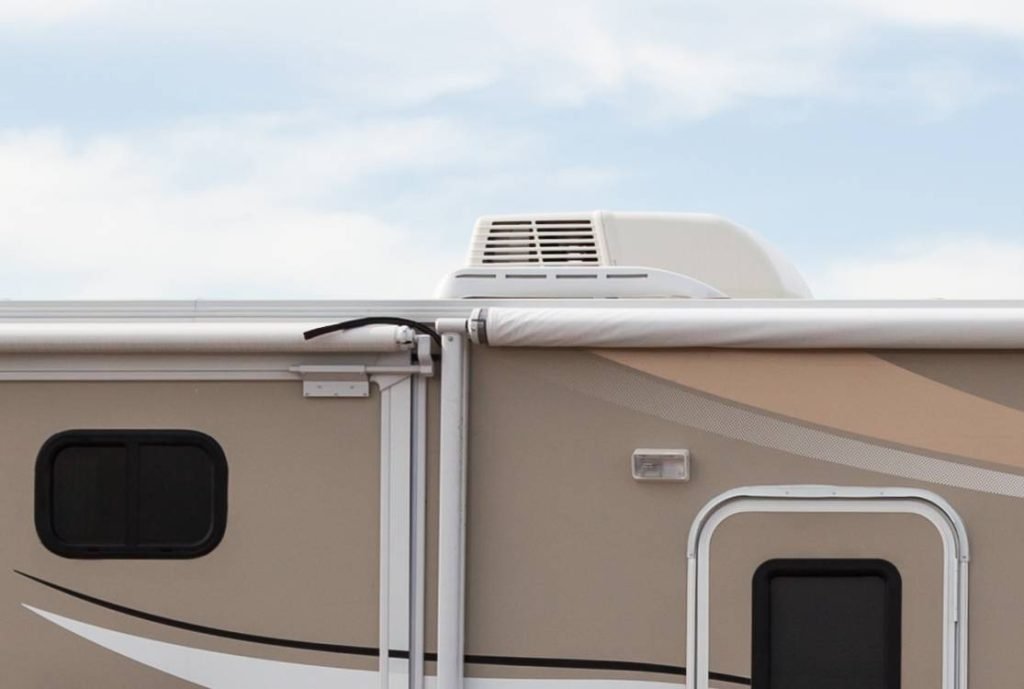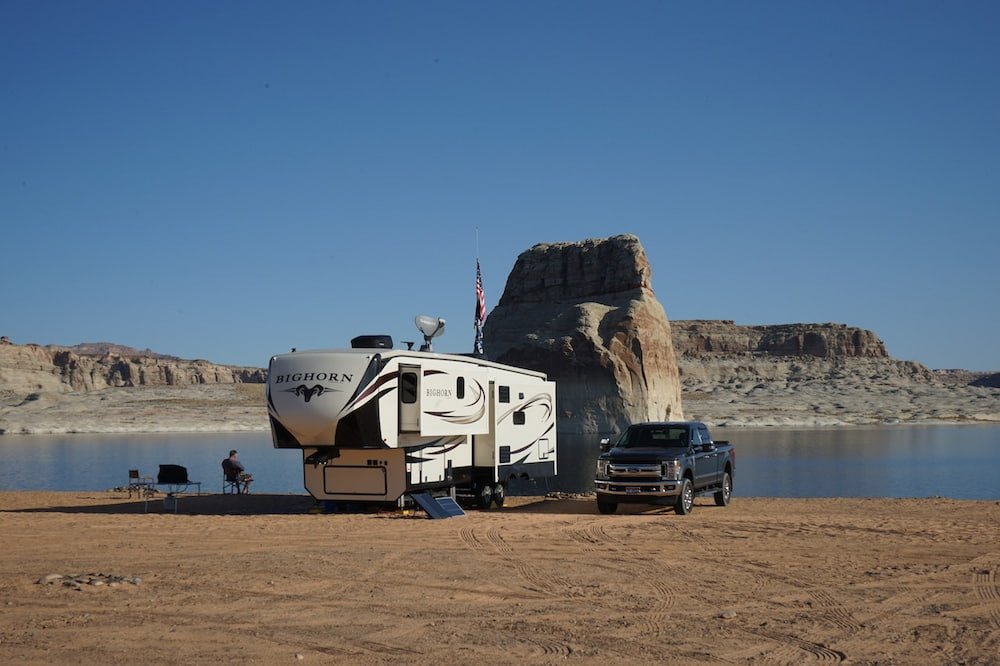One of the biggest challenges of boondocking is maintaining climate control, especially during the hot summer months. Your RV air conditioner can help you beat the heat, but can you run it while boondocking? The answer is not a simple yes or no.
It is possible to run your RV air conditioner while off the grid. If you are using a generator, the power output of that generator is the main factor to consider. If you are on battery power, your inverter size, battery capacity and solar capacity must all be factored in.
There are a variety of factors that influence your ability to run your air conditioner while boondocking. In this article, we’ll explore the ins and outs of running your RV air conditioner while boondocking, and provide you with some practical tips to make it work.
Factors to Consider Before Using Your RV AC While Boondocking
Before deciding if and how you will power up your RV air conditioner while you are boondocking, make sure you have considered each of the following variables:
- Power Requirements of Your AC Unit
- Power Output of Your Generator
- Capacity of Your Inverter
- Capacity of Your Battery and Solar System
1. Power Requirements of Your AC Unit
The first thing you will want to know is the size of your RV’s AC unit, which is measured in BTUs. The number of BTUs indicates the amount of energy the AC unit uses to remove heat from the inside air.
The vast majority of RV air conditioners are 15,000 BTU roof-mounted units that run on 120 volt AC power. Depending on its length, an RV might have one, two or three of these AC units. Each of these units draws 3500 watts when initially starting up (this is called “surge current”), then draws 1500 watts when running.
Some smaller RVs have 5000 BTU units that run on 120 volt AC power. These units require 1000 watts to start up and will use 450 watts when running continuously.
Some RV air conditioning units do not operate on 120 volt AC power, but instead are 12 volt DC units that can run directly off of the battery system. This is a newer technology that is best used in smaller RVs with less square footage needing to be cooled.
Look through your RV owner’s manual to determine the size and type of your RV’s AC.

The initial startup (the “surge current”) of a 120 volt AC air conditioner is the most important variable to pay attention to when calculating the power demands of the unit. When you are plugged into shore power at an RV park, you don’t need to think about your air conditioner turning on and off, since the shore power is supplying enough watts to your RV’s power system. For example, a 30 amp plug supplies 3600 continuous watts (30 amps x 120 volts) and a 50 amp plug supplies 6000 watts.
But when you are boondocking without hookups, and therefore need other power sources that will likely be limited (as we will discuss later in this article), every high-power demand must be paid attention to.
One way to reduce the initial startup (“surge current”) wattage of your RV’s AC is to install a soft start kit such as a MicroAir EasyStart. The EasyStart regulates the amount of voltage going to the motor of an AC unit when it starts up, gradually increasing the start-up current.
With an EasyStart, the start current is reduced up to 65-75%. For a 15,000 BTU unit that normally takes 3500 watts when starting, the EasyStart reduces that to be no more than the operating current of 1500 watts. This lower power requirement greatly helps when working with a more limited power supply.
If you have multiple AC units, remember that each of the AC units will have power demands, especially when starting up. Depending on your power supply, you may need to only use one AC unit while boondocking, and keep the other unit(s) turned off the entire time.
2. Power Output of Your Generator
If you are using a generator while boondocking and want to run your RV air conditioner, your generator’s power output, which is measured in watts, must be able to handle your AC’s power consumption.
Your generator’s power output (watts) can easily be found in your owner’s manual and is also often printed right on the side of the generator.
Once you familiarize yourself with the power requirements of your RV’s AC unit as well as the power output of your generator, you will know very clearly whether your generator is capable of powering your AC.
For example, as we discussed above, the 15,000 BTU roof-mounted AC that is installed on most RVs requires 3500 watts to start up and 1500 watts to run. If you have a 3500 watt generator or larger, you will have all you need to power up your AC and keep it running. If you have an EasyStart installed, a 2000 watt generator will be sufficient to run your AC.
If you have a factory installed on-board generator that is permanently wired into your power system, that generator will have enough wattage to be able to run your air conditioning unit.
3. Capacity of Your Inverter
If you don’t use a generator to provide 120 volt AC power directly to your RV, you will be relying on your 12 volt DC battery system to power everything, using what’s called an inverter. This built-in inverter is used to convert the 12 volt DC battery power to 120 volt AC power.
However, does your inverter have enough watts to run large 120 volt AC appliances such as an air conditioning unit? Remember that even with an EasyStart installed, a 15,000 BTU air conditioner will need 1500 watts to run.
Unfortunately, most RVs come with inverters that convert less than 1500 watts. In the minds of most RV manufacturers, a lower capacity inverter (typically 1200 watts) is much cheaper to install and is sufficient enough to run most things (such as small appliances and electronics) whenever the RV is unplugged.
With this kind of power system configuration that uses a lower capacity inverter, a boondocking RVer is expected to do without the power-hungry appliances such as an AC unit or a microwave. These larger appliances don’t even turn on whenever the RV is unplugged.
An automatic switch (called a transfer switch) is used to supply the 120 volt AC power to large appliances whenever the RV is plugged in, and will disconnect the power to those same appliances whenever the RV is not plugged in.
As we stated earlier, if you have an on-board generator that is wired permanently into your power system, your air conditioner and other large appliances are able to power on after you start your on-board generator, even if you are not plugged in shore power.
If your inverter can’t run your air conditioner and other large appliances, you may want to consider replacing your inverter with a higher capacity one. We highly recommend the Victron Energy MultiPlus-II. This MultiPlus model is actually an inverter, a converter (battery charger) and a transfer switch all in one. With a MultiPlus in place, your RV would be fully equipped to run your air conditioner and any other large appliance.
Installing a MultiPlus requires a high amount of technical know-how and likely a reworking of your RV’s power system. If you don’t feel comfortable taking on this kind of installation, you can do some online research or calling around to see who in your area could do the work for you.
We highly recommend you don’t try to modify your RV’s power system unless you are absolutely certain you understand what you are doing.
Note: If you are new to RVing, we recommend getting a complete understanding of how each of your appliances are powered. For example, your water heater is likely powered by 120 volt AC when AC is supplied, and powered by propane when it’s not. Your refrigerator may run on 120 volt AC when AC is supplied, or propane and 12 volt DC whenever you are disconnected from 120 volt AC power.
4. Capacity of Your Battery and Solar System
Assuming you have an inverter like a MultiPlus that is capable of powering your air conditioner, the next variable to factor in is your battery and solar system. You must have a battery and solar system that can handle running your AC as long as needed. A 15,000 BTU air conditioner drawing 1500 watts continuously will drain batteries quickly, so it’s necessary to have enough batteries to handle that drain and enough solar to continuously recharge the batteries as they drain.
If your batteries are lead acid, you shouldn’t try to use them for power-hungry appliances like an AC. Lead acid batteries won’t last long at all and if you drain them down below 50% capacity you might ruin them long term.
A large bank of lithium batteries, on the other hand, would have what it takes to run your AC for a while. We recommend Battle Born lithium batteries, and you would need to install a number of them to have a high enough battery capacity.
Battery capacity is measured in amp hours, a measurement used to indicate how much power the battery can provide before it runs out. A common lithium battery can provide 100 amp hours, so if you had five of them linked together your system would have a capacity of 500 amp hours.
To determine how fast a 15,000 BTU air conditioner will drain a 12 volt lithium battery system, the following formula is used:
Watts / Volts = Amps
Using this formula we know that a 15,000 BTU air conditioner using 1500 watts continuously from a 12 volt battery system would use up 125 amps (1500 watts / 12 volts ) from your battery system after only one hour! This is more than what one 100 amp lithium battery can provide. When we consider this reality, we see how important it is to have a fairly large bank of lithium batteries to be able to run your AC.
Note: Calculating amp use of a large RV appliance is often misunderstood when its power source could be either 120 volts AC (from shore power or a generator) or 12 volts DC (from the battery system). When a 15,000 BTU RV air conditioner is powered directly by 120 volts AC (from shore power or a generator), it draws 12.5 amps (1500 watts / 120 volts).
But when it’s powered by a 12 volt battery system, the air conditioner draws 125 amps from that system as we just described. Even though the 12 volts DC is being converted to 120 volts AC by the inverter, the power source is still 12 volts. Thus, 12 volts must be used in the formula to get the true amp draw from the battery system!
In addition to needing a large bank of lithium batteries, a large array of solar panels is required to recharge the bank of batteries. We stated earlier that when a 15,000 BTU air conditioner runs on battery it’s going to draw 1500 watts (or 125 amps) continuously from the battery system.
Thus, the array of solar panels needs to keep up with resupplying that same amount. A general rule of thumb is to have 250 watts of solar for every 100 amp hours of battery. A 500 amp hour battery bank should ideally be matched with 1250 watts of solar.
If your RV was equipped with this kind of battery and solar system, you could plan to run your AC unit for a while. You would know your solar panels were recharging your batteries at a good rate, and your panels would continue to recharge the batteries quickly after you turn off your AC.
Of course this is all assuming it was a sunny day and your solar panels were not being blocked by trees.
Things to Keep in Mind When Running Your AC
If you have everything you need to run your AC while boondocking, there are a few things to keep in mind.
- Your other appliances need power too. In this entire article, we’ve been focused on the power requirements and demands of the air conditioner. Keep in mind all of your other appliances and electronics that also will need power when you are boondocking.
- Larger generators are loud. If you decide to bring along a larger generator just to be able to run your AC, it will be much louder than a smaller generator. The generator noise might overcome the peace and quiet you would be enjoying otherwise.
- Cloudy weather may reduce your solar energy. If you are equipped to run your AC off of battery and solar and are hoping to use your AC, check the weather forecast to make sure you’ll be getting enough sun while you are boondocking.
Other Ways to Stay Cool
While running an RV air conditioner while boondocking is certainly possible with the right equipment, most RVs don’t have all that right equipment. Even if your RV is properly equipped, running your AC may not always be the most practical or efficient.
If you’re looking for alternative ways to stay cool when boondocking, here are some options to consider:
- Portable air conditioner: If you can’t or don’t want to run your large RV air conditioner, you can invest in a smaller, portable air conditioner that doesn’t draw as much power.
- Evaporative (swamp) cooler: Another alternative to traditional RV air conditioners is a swamp cooler. These units work by evaporating water to cool the air, and they can be an effective way to keep your RV cool in dry climates. However, they do require a constant supply of water, and they can’t be used in more humid climates, so they may not be practical in all boondocking situations.
- Natural ventilation: Don’t forget the availability of natural ventilation. By opening your windows and using fans, you can create a cross-breeze that will help keep your RV cool and comfortable. This is a great option if you want to conserve power and enjoy the fresh air.
Conclusion
Running your RV air conditioner while boondocking is definitely possible, but it requires having the right power systems and equipment. By bringing the right generator, or having the proper battery bank and array of solar panels, you can stay cool when enjoying the great outdoors.
If you’re not equipped to run your RV air conditioner while boondocking, there are other options to consider, such as portable air conditioners, swamp coolers, and natural ventilation. Choose the method that works best for your specific needs and situation.
Related Questions
How Can I Extend My Time Boondocking?
The best way to extend boondocking time is to expand your utility capacity and storage. Increasing your supply of power, water and propane as well as supplementing your black and grey tank capacity, will prolong your stay many days. By minimizing your usage of power, water, propane and sewer, you can lengthen your time boondocking even more. Read our article How To Extend Your Time Boondocking In An RV.
How Do I Bring More Water for Boondocking?
When boondocking in remote locations, the stay is often cut short because you run out of fresh water. Increasing the amount of fresh water you can carry will allow you to extend your time boondocking without you running out of water. Read our article How to Carry Extra Water in an RV – 5 Ways to Expand Capacity.

